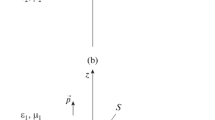Summary
The unique solution to the general vector problem of electromagnetic diffraction by a perfectly conducting plane screen of arbitrary configuration is obtained in the form of a convergent series. The radiation impinging on the plane screen originates from a spatially bounded source which is also of arbitrary configuration. The mathematical context used to obtain this solution is the Hilbert-space formulation of the angular-spectrum representation of plane waves.
Riassunto
L’unica soluzione al problema generale vettoriale della diffrazione elettromagnetica mediante uno schermo piano a conduzione perfetta di configurazione arbitraria si ottiene in forma di serie convergente. La radiazione che colpisce lo schermo piano deriva da una fonte spazialmente limitata, anch’essa di configurazione arbitraria. Il contesto matematico usato per ottenere questa soluzione è la formulazione nello spazio di Hilbert della rappresentazione dello spettro angolare delle onde piane.
Резюме
В форме сходящегося ряда получается единственное решение общей векторной проблемы электромагнитной дифракции на идеально проводящем плоском экране произвольной конфигуации. Излучение, падающее на плоский экран, происходит из пространственно ограниченного источника, который также также имеет произвольную конфигурацию. Математический подход, использованный для получения этого решения, представляет формулировку в гильбертовом пространстве представления углового спектра плоских волн.
Similar content being viewed by others
References
W. D. Montgomery:Nuovo Cimento B,4, 275 (1971).
W. D. Montgomery:J. Opt. Soc. Am. A,58, 720 (1968). Verbal presentation.
W. D. Montgomery:J. Opt. Soc. Am.,58, 1112 (1968).
We define\(f = (\hat f_1 ,\hat f_2 ,\hat f_3 )\) as the Fourier transform of itsx, y, z components, and\(f \cdot \varrho = \xi \hat f_1 + \eta \hat f_2 + \zeta \hat f_3 \)
There is also a left-propagating reflected boundary fieldr=[r, s], Using the results of ref. (8) we can show that the power interaction betweena andr, together withf, provides the screen with no net power loss or gain.
R. Sikorski:Boolean Algebras (Berlin, 1964), p. 5.
TheD σ,K σ and ℛσ denote the domain, kernel and range, respectively, of the transformationJ which maps the inputa into the outputf (see I).
W. D. Montgomery:Nuovo Cimento B,15, 94 (1973). Note the change of notation fromG e toG m and fromG h toG e.
W. D. Montgomery:Nuovo Cimento B,46, 33 (1978).
This result was presented at the meeting onIntegral-Equation Methods in Engineering December 7–12, 1980 held at the Mathematical Research Institute, Oberwolfach, Federal Republic of Germany.
W. D. Montgomery:J. Opt. Soc. Am.,67, 1437 (1977). Verbal presentation.
P. R. Halmos:A Hilbert Space Problem Book (Princeton, N. J., 1967), p. 257.
D. C. Youla:IEEE Trans. Circuits Syst., CAS-25, 694 (1978).
Author information
Authors and Affiliations
Additional information
To speed up publication, the author of this paper has agreed to not reccive the proofs for correction.
This work has been supported by the National Science and Engineering Research Council of Canada.
Traduzione a cura della Redazione.
Переведено редакцией.
Rights and permissions
About this article
Cite this article
Montgomery, W.D. Diffraction by perfectly conducting plane screens. Nuov Cim B 71, 65–74 (1982). https://doi.org/10.1007/BF02721694
Received:
Revised:
Published:
Issue Date:
DOI: https://doi.org/10.1007/BF02721694



